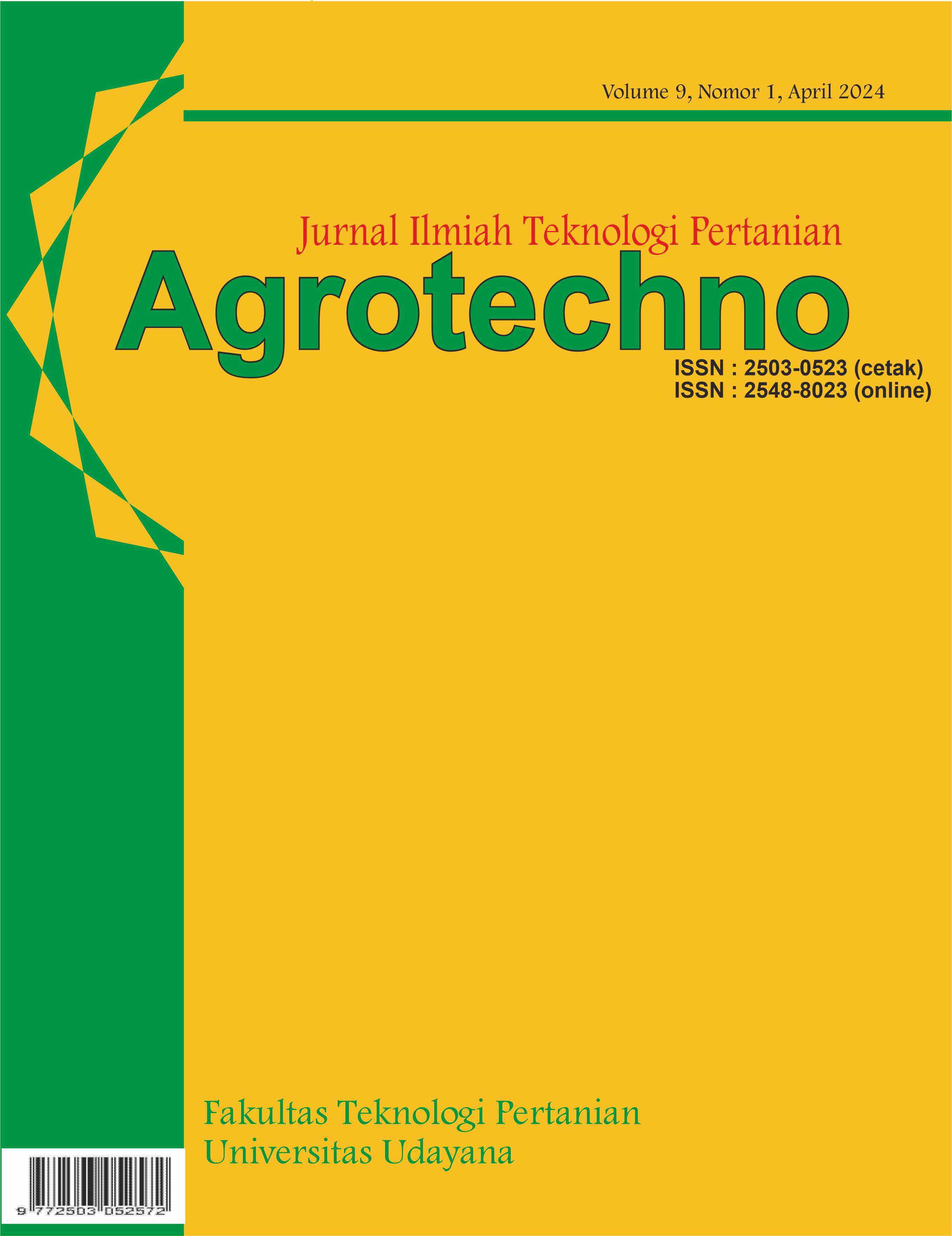Analisis Emisi Gas Buang dari Daur Hidup (Life Cycle Assessment) Produk Tahu di Perusahaan XYZ Denpasar
Abstract
Micro, small, and medium enterprises (MSMEs) are people's economic activities that have a major impact on increasing the level of the Indonesian economy. However, small industries often become contributors to waste due to the minimal level of energy efficiency and use of technology. One of the small industries in Denpasar, namely the XYZ company, produces tofu on a home scale, which is located between residential areas. Since 1995, this business has consistently produced with a capacity of 100 kg of soybeans/day. Tofu production produces carbon emissions from the use of electric-powered machines and firewood. Life Cycle Assessment (LCA) is a calculation to identify and analyze the environmental impact of the life cycle, showing important points of CO2 emission so that improvements can be made efficiently. In this study, the boundaries used are gate-to-gate, or analysis refers to all stages of tofu production in the factory, from soaking to packaging. This method refers to ISO 14040 and IPCC Guidelines for National Greenhouse Gas Inventories 2006 to measure the carbon footprint and environmental impact of tofu production. Environmental impact analysis was carried out in the OpenLCA series 1.11.0 software using the Agribalyse 3.0.1 database and the IPCC 2013 GWP 100a method. As a result, this study shows that in one production run, the XYZ company will produce 488.94636 kg CO2e of climate change and a carbon footprint of 1,47 kg CO2/kg tofu.
Abstrak
Usaha Mikro, Kecil dan Menengah (UMKM) adalah kegiatan ekonomi rakyat yang memberikan dampak besar terhadap peningkatan taraf perekonomian Indonesia. Namun, industri kecil seringkali menjadi penyumbang sampah karena taraf efisiensi energi dan penggunaan teknologi yang minim. Salah satu UMKM di Denpasar, yaitu perusahaan XYZ memproduksi tahu pada skala rumahan yang terletak di antara pemukiman masyarakat. Sejak tahun 1995, usaha ini secara konsisten melakukan produksi dengan kapasitas 100 kg kedelai/hari. Pembuatan tahu menghasilkan emisi karbon dari penggunaan mesin bertenaga listrik dan pembakaran serbuk kayu. Emisi tersebut menjadi salah satu polutan pemicu besar kerusakan ekosistem dan kesehatan makhluk hidup. Life Cycle Assessment (LCA) adalah perhitungan untuk mengidentifikasi dan menganalisis dampak lingkungan dari daur hidup pembuatan produk. Metode ini memberikan titik-titik penting penghasil emisi CO2 sehingga perbaikan dapat dilakukan secara efisien. Dalam penelitian ini, batasan yang digunakan yakni gate-to-gate, atau analisis mengacu pada seluruh tahapan produksi tahu di pabrik seperti perendaman hingga pengemasan. Metode ini dilakukan dengan mengacu pada ISO 14040 dan IPCC Guidelines for National Greenhouse Gas Inventories 2006 untuk menakar jejak karbon dan dampak lingkungan dari produksi tahu. Analisis dampak lingkungan dilakukan pada software OpenLCA seri 1.11.0 menggunakan database Agribalyse 3.0.1 dan metode IPCC 2013 GWP 100a. Hasilnya, penelitian ini menunjukkan bahwa dalam satu kali produksi, perusahaan XYZ akan menghasilkan perubahan iklim sebesar 488,94636 kg CO2e dan jejak karbon sebesar 1,47 kg CO2e/kg tahu.
Downloads
References
Amalia, R. N., Devy, S. D., Kurniawan, A. S., Hasanah, N., Salsabila, E. D., Ratnawati, D. A., Fadil, F. M., Syarif, N. A. & Aturdin, G. A. (2022). Potensi limbah cair tahu sebagai pupuk organik cair di RT. 31 Kelurahan Lempake Kota Samarinda. Jurnal Pengabdian Masyarakat Universitas Mulawarman, 1(1), 36 – 41.
Ambika, M. (2010). Studi analisa karakteristik gas CO2 hasil pembakaran kayu dengan proses fast burning dan slow burning. Malang: Universitas Brawijaya.
Astari, R. G. (2012). Studi jejak karbon dari aktivitas pemukiman di Kecamatan Pademangan Kotamadya Jakarta Utara. Depok: Universitas Indonesia.
Febrina, L., Wahyudi, D. & Harki, R. D. (2021). Kajian emisi CO2 berdasarkan jejak karbon sekunder di lingkungan Universitas Sahid Jakarta. Jurnal SEOI, 3(1), 40 – 49.
Hanim, L & Noorman. (2018). UMKM (usaha mikro kecil dan menengah) dan bentuk-bentuk usaha. Universitas Islam Sultan Agung: Unissula Press.
Herlambang, S., Rina, S, Purwono, B. S. & Sutino, H. T. (2017). Biomassa sebagai sumber energi masa depan. Universitas Pembangunan Nasional “Veteran” Yogyakarta: Lembaga Penelitian dan Pengabdian Masyarakat.
Intergovernmental Panel on Climate Change. (2006). Guidelines for national greenhouse gas inventories – stationary combustion 2006. Journal Of Applied Mechanics and Technical Physics, 7(6), 69 – 70.
ISO 14044. (2017). Enviromental management – life cycle assessment – requirements and guidelines – amandement 1. Jenewa: Switzerland.
International Energy Agency. (2015). CO2 emissions from fuel combustion highlighs. Paris: France.
Kaswinarni, F. (2007). Kajian teknis pengolahan limbah padat dan cair industri tahu studi kasus industri tahu Tandang Semarang, sederhana kendal dan gagak sipat Boyolali. Semarang: Universitas Diponegoro.
Kementerian Energi dan Sumber Daya Mineral. (2020). Inventarisasi emisi GRK bidang energi. Jakarta: Pusat Data dan Teknologi Informasi Energi dan Sumber Daya Mineral.
Marcell & Anondho, B. (2023). Analisis jumlah carbon footprint semen pada pekerjaan plester dinding proyek rumah tinggal. Jurnal Mitra Teknik Sipil, 6(2), 333 – 342.
Nugrahayu, Q., Nurjannah, N. K., & Hakim, L. (2017). Estimasi emisi karbon dioksida dari sektor permukiman di Kota Yogyakarta menggunakan IPCC Guidelines. Jurnal Sains dan Teknologi Lingkungan 9(10), 25 – 36.
Organization for Economic Co-operation and Development. (2018). Accelerating the development and diffusion of low-emissions innovations. France: Paris.
Pagoray, H., Sulistyawati & Fitriyani. (2021). Limbah cair industri tahu dan dampaknya terhadap kualitas air dan biota perairan. Jurnal Pertanian Terpadu, 9(1), 53 – 65.
Purnama, F. A., Dewi, L. & Hastuti, S. P. (2013). Kadar air, abu, protein dan karbohidrat pada pembuatan tempe. Salatiga: Universitas Kristen Satya Wacana.
Pusparisa, Y. (2020). Skenario jumlah emisi karbon dioksida (CO2) per sektor 2050. Jakarta: Data Indonesia.
Rahmawati, E. (2022). Analisis life cycle assesment untuk menentukan dampak lingkungan pada proses produksi tahu di industri kecil “UD. X” Desa Sidojangkung, Kecamatan Menganti, Gresik. Surabaya: Universitas Islam Negeri Sunan Ampel.
Ridha, D. M., Purbo, A., Wibowo, A., Tobing, L. B., & Widyaningtyas, N. (2016). Perubahan iklim, perjanjian paris dan nationally determined contribution. Jakarta: Direktorat Jenderal Pengendalian Perubahan Iklim.
Sahirman, S. & Ardiansyah. (2014). Perkiraan carbon footprint industri tahu Banyumas – langkah awal menuju industri hijau. Prosiding Seminar Nasional Sains dan Pendidikan Sains, 5(1), 344 – 348.
Wahyudi, J. (2017). Penerapan life cycle assessment untuk menakar emisi gas rumah kaca yang dihasilkan dari aktivitas produksi tahu. The 6th University Research Colloquium, 475 – 480.
Yuwono, S. S. (2007). Analisis faktor-faktor penentu rendemen dan tekstur tahu di industri tahu yang menggunakan koagulan whey terfermentasi. Malang: Universitas Brawijaya.










